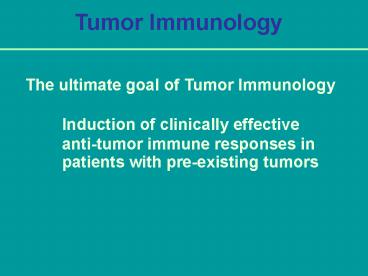Tumor Immunology - PowerPoint PPT Presentation
1 / 32
Title:
Tumor Immunology
Description:
Carcinoma: Cancer of endo or ectoderm e.g. Skin or epithelial lining of organs ... eradicate tumor. Tumor Immunity. Innate Immunity. Macrophage. Natural killer cells ... – PowerPoint PPT presentation
Number of Views:875
Avg rating:3.0/5.0
Title: Tumor Immunology
1
Tumor Immunology
The ultimate goal of Tumor Immunology Induction
of clinically effective anti-tumor immune
responses in patients with pre-existing tumors
2
Types of Cancer
- Carcinoma Cancer of endo or ectoderm e.g. Skin
or epithelial lining of organs - Sarcomas Cancer of mesoderm e.g. bone, muscles
- Leukemias and Lymphomas Cancers of hematopoietic
cells
3
Evidence for Immunologic Defenses Against Cancer
in Humans
- Immune cells around tumor mass
- Hyperplasia of local lymph node
- Increment of MHC class II and ICAM-1
- Immunodeficiency is associated with increased
incidence of cancers - B-cell lymphomas - AIDS
- Transplant patients
4
The 10 leading Causes of Death in the US
5
Tumor Immunology
Characterization of tumor antigens Immune
responses to tumors Evasion of tumor from
immunosurvillance Immunotherapy
6
Immunologic Defenses Against Cancer in
Experimental Animals
- Tumors induced by the same virus express the same
virally determined antigens - Tumors induced by the same chemical are
antigenically distinct - If a tumor is removed from a mouse, and the mouse
later re-injected with the same tumor cells, no
tumor will form
7
(No Transcript)
8
What are the Antigens Expressed on Tumors?
- Tumor Specific Antigens (TSA)
- Are only found on tumor cells.
- Arise due to point mutations or rearrangement of
cellular genes. - Can be derived from viral antigens of
transforming viruses. - Tumor Associated Antigens (TAA)
- Found on both normal and neoplastic tissue, but
the expression is greatly altered/increased on
cancer cells. - Oncofetal antigens are developmental antigens
which become derepressed. (CEA and AFP) - Differentiation antigens are tissue specific.
- Altered modification of a protein could be an
antigen.
9
Tumor Immunity
-Tumors express antigens that are recognized as
foreign by the immune system of the
tumor-bearing host -Immune responses frequently
fail to prevent the growth of tumors -The immune
system can be stimulated to effectively kill
tumor cells and eradicate tumor
10
Tumor Immunity
Innate Immunity Macrophage Natural killer
cells Adaptive Immunity CTLs Antibody
11
Innate immune system I
- Macrophages
- are activated by IFN?
- kill target cells by releasing TNF?, radical
oxygen species, NO, and proteases
12
II
- Natural Killer Cells (NK cells)
- can mediate cytotoxicity of cells which have
down-regulated their MHC I - part of the innate immune system involved in
immune surveillance - mediate cytotoxicity by using perforin and
granzymes, Fas L, and IFN? - NK deficient animals have a higher incidence of
neoplastic disease
13
Innate Immunity NK cells
14
Adaptive Immunity
Cell-mediated immunity CD8 CTLs Humoral
immunity Antibody activating complement ADCC
(macrophage, NK cell)
15
Tumor Immunity
16
(No Transcript)
17
The Humoral Immune SystemWhat role does it play?
- Antibodies may bind antigens on the tumor. This
may result in - complement fixation on the tumor cell
- antibody dependent cytotoxicity by NK cells,
macrophages and CD8 killer T cells
18
Antibody Effector Functions
Carter P., Nature Rev Cancer.20011118-130
19
Mechanisms of Immunologic Cytotoxicity
- Macrophage-mediated cytotoxicity
- Natural killer cell-mediated cytotoxicity
- T cell-mediated cytotoxicity
- Antibody-dependent cell-mediated cytotoxicity
- Complement-mediated cytotoxicity
20
(No Transcript)
21
How Does the Tumor Evade the Immune System?
- Low immunogenicity low expression of adhesion
molecules, MHC, co-stimulatory molecules, tumor
antigens - Antigen the tumor may not express antigen
against which the immune system is reactive.
mutation of tumor antigens and antigen masking - Immunosuppression tumor cells may make compounds
that suppress immune cells (MHC class 1). TGF-b - Speed of tumor growth may outpace the immune
system - Antigen released may saturate the TCRs of T
cells or released immunoglobulins
22
Cancer Immunotherapy
Active Immunotherapy Adjuvants Cancer
vaccines Cytokines Passive Immunotherapy Monoclo
nal antibodies In vitro-activated LAK
23
Adjuvants
Inflammatory substances BCG (macrophage
activator) Polyclonal activators of
T-lymphocytes anti-CD3 antibody (low dose)
24
Cancer Vaccines
Abbas,Lichtman and Pobber, Cellular and
Molecular Immunology. W.B. Saunders. 1999. Fig.
17-5
25
Cytokines
- IL-2 ? increment of LAK and NK activity TNF, IL-1
and IFN-gamma - TNF toxic in high level
- IFN-alpha increment of NK activity and
augmentation of MHC class I expression - IFN-gamma increment of NK and macrophage
activities and augmentation of MHC expression
26
MHC Adenovirus- Induced Tumors
27
Cancer Immunotherapy
Active Immunotherapy Adjuvants Cancer
vaccines Cytokines Passive Immunotherapy Monoclo
nal antibodies In vitro-activated LAK
28
(No Transcript)
29
Monoclonal Antibodies
30
Cancer Immunotherapy
Active Immunotherapy Adjuvants Cancer
vaccines Cytokines Passive Immunotherapy Monoclo
nal antibodies In vitro-activated LAK
31
(No Transcript)
32
Treatment of Melanoma with LAK cells IL-2
Before
After









![Overview of Immunology [1] PowerPoint PPT Presentation](https://s3.amazonaws.com/images.powershow.com/6184553.th0.jpg?_=20150228120)





















